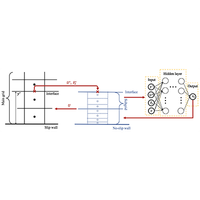To tackle the challenging near-wall turbulence modeling while preserving low computational cost, the near-wall nonoverlapping domain decomposition (NDD) method is proposed, incorporating the machine-learning technique. Using recently proposed implicit NDD (INDD), the solution can be calculated with a Robin-type (slip) wall boundary condition on a relatively coarse mesh and then corrected in the near-wall region at every iteration through an estimated turbulent viscosity profile obtained from a neural network. To maintain a reasonable complexity with acceptable accuracy, only the near-wall field properties, i.e., wall-normal distance, near-wall velocities, streamwise pressure gradients, and one near-wall scale parameter, are employed as the input features for the neural network. The benefit of incorporating machine learning is twofold. First, the near-wall turbulent viscosity is predicted more accurately than by the traditional algebraic functions used in the approximate approach. Second, similarly to the conventional NDD, the present simulations save one order of computational cost over the fully resolved one-block simulations. The accuracy and efficiency of the method are demonstrated on test cases with the model, including turbulent flows in a channel and an asymmetric diffuser at different Reynolds numbers. Results compare favorably with the one-block benchmark solutions and show a better agreement when compared with approximate NDD predictions. In the latter case, a variation of diffuser geometry is also considered to test the model performance on engineering design tasks with another turbulent model (i.e., Spalart-Allmaras), showing good generalization capability on different turbulence closures.
- Received 31 October 2023
- Accepted 7 March 2024
DOI:https://doi.org/10.1103/PhysRevFluids.9.044603
©2024 American Physical Society
Fluid Dynamics






Add Comment